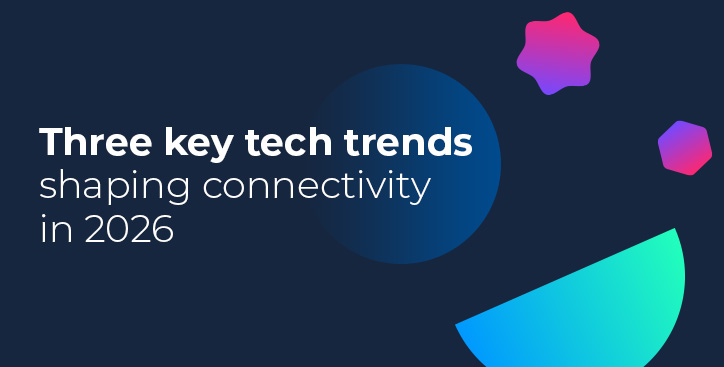3 IoT applications that should consider private networking
By Alex Hawkes|12 April, 2023

As IoT (Internet of Things) device form factors have got smaller and batteries have got better, use cases for IoT applications have expanded into every sector.
From trucks, to shipping containers, people, to cattle, an organisation’s assets can be fixed, mobile, autonomous and even sentient - relaying information that can deliver new business insights and competitive advantage.
But these benefits only come if the information is able to get to the right place at the right time.
The brain where all the data processing happens is usually a public cloud instance or a private data centre, and the IoT-enabled endpoint - whether a tractor, a building sensor, or a cow, may be very far away.
1. IoT asset management
Asset tracking makes use of IoT applications to connect items in your company’s inventory to your management system, giving you real-time insights such as location, environmental conditions and asset status.
Analysts have identified asset tracking as the fastest growing industrial IoT market and it is expected that most connected devices will be location aware within the next decade.
Historically a job for humans armed with clipboards and then spreadsheets, IoT-based asset tracking can significantly reduce human error related to quantities and locations as well as cut down on losses and theft by replacing manual asset management with real-time location systems (RTLS) tracking.
While asset management and supply chain often go hand in hand when it comes to IoT, assets can be much more than product inventory.
In construction or farming, it also includes large, expensive pieces of machinery that are moved from job to job. These require trigger alerts if the equipment is moved unexpectedly, as well as updates on preventative maintenance.
Or asset could refer to your workforce. Outfitted with an on-person tracker, IoT increase safety and whereabouts for workers in remote or dangerous locations, whether the location is indoor or outdoor in large areas such as loggers, forest firefighters, or search and rescue teams and can help you better manage responses to situations from a central command centre.
2. Logistics and supply chain
Adding IoT sensors to shipping containers, crates or trucks gives the asset or inventory a digital footprint, enabling you to track its location and movement in real time.
IoT applications in logistics can help businesses better understand the behaviour of assets. When used in combination with asset intelligence systems, they can help make better decisions, gain real-time operational insights and delivery predictions, opening up new revenue streams.
Increasingly, IoT can not only enrich the location and status of a shipping container, but also the cargo inside.
IoT connectivity can relay the status of containers with chilled or frozen functionality, and in cases where shipments of cargo are time sensitive such as with medicine or food, can inform how long the container has been in its current location and if it is expected to reach its destination on time.
For both asset management and logistics, IoT connectivity can help beat inefficiencies in:
- Container utilisation: Where are all your containers and are they where they are supposed to be? Are they full or empty? Are the ones with specialist functionality such as temperature control seeing optimal usage?
- Fleet management: Supply chain chaos has been in the news a lot recently, as ships trucks and delivery vans face lengthy delays. Sustainability is another core focus for transport companies, which are under more pressure to reduce their carbon footprint.
Leveraging IoT connectivity, transport companies can track and monitor their fleet in real-time to optimise their fleet, reduce fuel costs and improve overall efficiency. - Inventory management: Historically, inventory management had been a very manual process, largely restricted to endpoints, with an item checked out of location A and logged into location B, and its journey in between these two points remaining ‘off radar’.
As a result, assets can and frequently do get ‘lost’, requiring an employee to spend time tracking them down, or the company writing them off.
An effective end-to-end inventory management setup not only helps with optimisation and rationalisation, but also enables transport and logistics organisations to scale their businesses globally.
3. Payment networks
Payments networks are a vital function of the banking system, enabling frequent touchpoints with customers.
Today point of Sale (PoS) devices take many different shapes and forms – from vending machines, coffee machines and ticket machines – all of which need to be connected directly back to the cloud or data centre, or to a local hub, to relay sales and inventory information.
When it comes to payment networks, security is paramount. These networks handle sensitive customer data and transaction information and require a secure path from PoS device to the cloud. There are also data sovereignty and regulatory frameworks to consider.
Security and reliability with Edge SIM
IoT applications are increasingly reliant on an uninterrupted flow of data between device and the cloud.
To prevent IoT applications being vulnerable to attacks via the public internet, Console Connect recently launched Edge SIM.
Edge SIM ensures IoT traffic avoids the public internet, and is the world’s first private connectivity solution to dynamically and securely route traffic directly between IoT devices and clouds globally over a private network.
As data volumes and network complexity rises, so do costs.
Edge SIM optimises IoT networks by connecting devices directly to any of the major IoT cloud platforms, including AWS, Google Cloud, Microsoft Azure, Oracle Cloud, IBM Cloud, Alibaba Cloud and more.
Businesses can dynamically link together their enterprise locations and network environments, including data centres, Wide Area Networks (WAN) and last mile access using wireless connectivity.
Edge SIM gives businesses greater control over the flow of data from their devices to the cloud – improving efficiency and helping with local regulatory requirements.



.jpg)





.jpg)